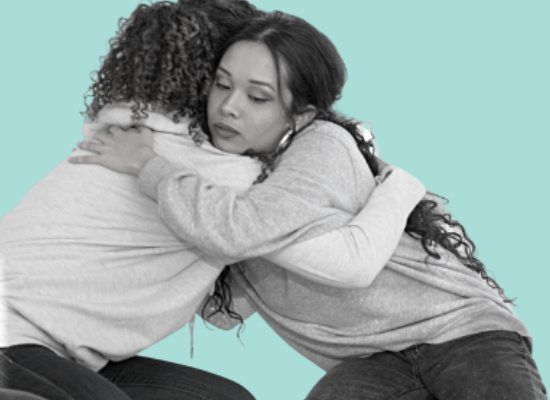
Stephanie Hepburn is a writer in New Orleans. She is the editor in chief of #CrisisTalk. You can reach her at .
Nationwide, kids in psychiatric crisis often bounce in and out of hospitalization. “Many times, it’s not the appropriate course of treatment because hospitals are intended for acute, not long-term, stabilization,” says Andrea Rifkind, LCSW-C, program director and therapist at Sheppard Pratt Health System’s Care and Connection for Families in Montgomery County, Maryland.
There isn’t a sufficient continuum of crisis services in most communities, and even fewer exist for children in distress. Rifkind says the result is that kids and their families have scarce options outside the emergency room, where they can face extended delays as they wait for an opening at a psychiatric hospital.
16-year-old Reina Chiang told #CrisisTalk that she spent 2.5 days waiting in a Maryland emergency room in 2019. “There’s a lot of sitting around,” she said. Once in the hospital, the focus isn’t long-term treatment. “It’s a short-term bandaid,” she stated. “You’re just there for extended amounts of time, with people watching you,” she said. “They’re primarily making sure you don’t harm yourself, and that’s it.” Chiang also noted that a psychiatric hospital is a scary place for kids. “It’s kind of like a prison with a lot of restrictions and not much to do,” she said.
Rifkind says a way to divert young people from the emergency room and inpatient hospitalization is through in-home stabilization. It’s not a mobile crisis service, which provides rapid response to people in a mental health crisis, providing assessment, de-escalation, and referrals to community services. Interactions might last up to a few days. In-home stabilization is a short-term crisis intervention that can last between 6 to 16 weeks, depending on the program. “Both,” she says, “are integral to the crisis continuum.” In some communities, mobile crisis providers can refer people to in-home stabilization programs.
There are many types of in-home stabilization programs. For instance, rising in popularity in the Netherlands is Intensive Home Treatment, where multidisciplinary teams, known as Crisis Resolution Teams, go to the homes of people experiencing urgent psychiatric issues. While not new—for instance, Dr. David Heath started the first intensive home treatment in Canada, the Hazelglen program, in 1989—they’ve picked up in popularity as an alternative to psychiatric admission across the world, including in Canada, New Zealand, the United Kingdom, and the United States.
Six years ago, Family Services Inc., a nonprofit mental health and social services agency, launched Care and Connection for Families in Montgomery County to help lessen the child to emergency room, inpatient hospitalization, or juvenile detention pipeline. Today, the program is integrated with Sheppard Pratt. It’s a fully grant-funded in-home crisis stabilization for young people, ages 6 to 18, experiencing a mental health crisis. “We focus on short-term, whole-family crisis intervention and counseling services,” says Rifkind, “to help the child and their family recover.” With a budget of $529,213.60 and 5.5 full-time staff, the program serves roughly 80 kids and their families annually.
While the average client age is middle schoolers 13-14, Rifkind points out that in recent months, the program has experienced a spike in referrals for elementary school students who are expressing suicidal ideation.
As states prepare for 988—the three-digit number for behavioral health emergencies that must be live by July 16, 2022—Rifkind hopes they’ll expand their crisis continuum to include in-home stabilization for young people. “It allows us to meet children where they are,” she says.
To Rifkind, meeting young people and their families “where they are” means eliminating barriers to care, whether that’s physical, financial, or a lack of exposure and awareness of mental health and therapy. In-home stabilization, she points out, also brings the service to populations that might be otherwise hard to reach. The vast majority of Care and Connection for Families clients are Latinx or Black. Many are struggling financially. “Before our program, some of our clients couldn’t attend therapy appointments because they didn’t have transportation,” she says. Having services go to the client makes them far more accessible.
Another common barrier to care is language. That’s why the in-home stabilization program provides crisis intervention and counseling services in English and Spanish, with access to interpreting services in most languages, including American Sign Language. Rifkind points out that this is just one of the benefits of being part of Sheppard Pratt.
There is a time and place for hospitalization, notes Rifkind, but it can also withdraw a young person from their natural support system, connections that might be a protective factor. Also, in-home stabilization can make it easier to build trust and rapport with clients. “In our experience,” she says, “young people are comfortable in a less formal, traditional therapeutic space.”
Families typically learn of the in-home stabilization program through the Montgomery County Crisis Center or the Local Behavioral Health Authority, which funds the program. Rifkind says some kids who enter the program were recently discharged from a hospital or residential treatment center. “They’re stepping down from a higher level of care,” she says, “and we’re helping them transition back into their home.” Other young people are referred to the program because they’ve experienced a recent trauma in their life or have chronic school absences.
Schools are the largest referral source of youth to the county crisis center. A school counselor or psychologist might send a student to the crisis center to have an assessment, often allowing the child to bypass hospitalization and enter the in-home stabilization program.
Unfortunately, the Covid pandemic threw a wrench into the number of referrals the program received. “We experienced large decreases,” says Rifkind. They went from 82 clients in the 2019 fiscal year to 62 last year, and 85% of the referrals in the 2020 fiscal year took place before the pandemic. “Without in-person school, it’s far harder to identify kids who are struggling or in crisis.” The program’s data mirrors what McKinsey’s Center for Societal Benefit through Healthcare found nationally: that children experienced the largest decrease in behavioral health services use during the pandemic. McKinsey’s tracker—Tracking US behavioral health service use during COVID-19—includes data from over 20 million Americans covered by private insurance, Medicaid, or Medicare.
Rifkind is happy to report the in-home stabilization program is back to full capacity. One month from the close of the 2021 fiscal year, the program already has had 88 referrals—42% took place between March 1 and May 25, aligning with schools in the county reopening. For many students in Montgomery County, this was the first time they’d been back in the classroom since March 2020.
Historically, during the summer months, the program experiences dips in referrals for the same reason they decreased during the pandemic: kids aren’t in the classroom. However, Rifkind expects this summer will look different. “As schools try to bridge academic gaps resulting from Covid shutdowns, there will likely be more kids in summer school programming,” she says. Even though communities are opening up, she’s quick to point out that kids and their families continue to experience ongoing challenges from the pandemic.
The program’s integrative approach engages schools and any providers working with the young person. “Our staff is tapping into a wide circle of people,” says Rifkind, “to stabilize the child and family.” Many of the systems Care and Connection for Families engage are siloed, which doesn’t behoove the young person. “We work hard to foster coordination, and usually, people are open and appreciative of the effort because it helps the youth in crisis.” The team also works to increase child and parent involvement at school.
The program’s services are available at no cost to families regardless of insurance as long as the child is a Montgomery County resident. “That means,” says Rifkind, “we’re able to serve youth who are uninsured, have private insurance, or who are on Maryland Medical Assistance like Medicaid or the Children’s Health Insurance Program.”
Unlike programs that have to bill to receive reimbursement, being entirely grant-funded gives Rifkind and her staff the needed flexibility to provide individualized care. “We can sit with a child in crisis for hours if that’s what they need.” They can also offer psycho-education to parents or individual therapy or family therapy with and without the child. “Not having billing restraints allows us to be creative and meet the client where they are,” she says, “and provide a range of individualized services to the youth and family.”
However, what young people need vastly differs depending on the person or where they are in their treatment and recovery process. Some kids require a higher intensity of services throughout the week, with therapeutic contact every day, while others need an in-person visit once to three times a week. “Treatments,” says Rifkind, “can scale up or down to match a client’s needs.”
How much clinical contact a child needs also depends on safety concerns. That’s because many kids in the program are dealing with suicidality or self-harm. “Some have dealt with suicidal ideation,” she says, “while others have had multiple suicide attempts and hospitalizations.” The program also works with kids grappling with aggression, some of whom are aggressive toward family members at home. That might be how the young person expresses their mental health needs, points out Rifkind.
The program aims to provide treatment and help children develop coping skills using a strength-based approach. “We help them engage in activities that match their strengths and are most likely to improve their mental health,” says Rifkind. For example, maybe the child relishes their role as an artist, sibling, or student. “If we see there’s an aspect of the person’s life helping them to feel stronger and build tolerance for dealing with adversity, we want to help foster that any way we can.”
The program assigns each young person to a team that includes a therapist and an in-home stabilizer. The latter fulfills the roles of both case manager and mentor. “I call them our secret sauce,” laughs Rifkind. The client and therapist set therapeutic goals, and the in-home stabilizer reinforces these goals. “If an aim is to work on relaxation and mindfulness techniques,” she says, “the in-home stabilizer will help the child practice.”
The in-home stabilizer also puts resources in place for the family. That includes basic needs like food, housing, and clothing. “When we have a family whose basic needs aren’t being met, which we see every day,” says Rifkind, “it’s very hard for parents to focus on mental health needs.” During winter months, for example, in-home stabilizers make sure their young clients have winter coats, food to eat, and that the utilities are on. “All the while,” she says, “they’re continuing dialogue with the family and team to put together a discharge plan that’s going to best support the family.”
The team works with the child for anywhere between 8 and 16 weeks and connects them to long-term services, ensuring that resources are in place. “That way, when it’s time for discharge, there’s a strong safety net in place for the child and their family,” says Rifkind.
Family members can struggle to understand why their child or sibling is experiencing mental health challenges. Or a strained familial relationship can make recovery challenging, points out Rifkind. The family member might unintentionally use hurtful language that pushes the child away. “We meet families where they are to help them understand the youth’s mental health needs,” she says, “and how best to support the child to get to a better place.”
“Sometimes, we’re the first intervention and a family’s first experience with mental health providers. The dynamic will differ from a family that’s been through many cycles of hospitalizations.”
During Covid and corresponding social distancing requirements, meeting clients has taken some creativity, notes Rifkind. Therapists and in-home stabilizers have met young people on porches, yards, or at nearby parks. “We’ve found tucked away spaces to have confidential conversations with our clients,” she says.
Rifkind points out that during Covid, stress levels among clients have risen, both for young people and their parents. “We’re seeing stress in parents in a way we didn’t before, and we’ve always seen parents in crisis,” she says. “The Covid experience is taking a toll on them.” Even with communities opening up, Covid continues to make connecting children with long-term services challenging because of ongoing physical distancing requirements. Rifkind notes that kids have been grateful for the in-person connection the program provides.
The default mental health provider of police, emergency room, inpatient hospitalization, and juvenile detention is costly for the community, the young person in crisis, and their families. “When appropriate, in-home crisis stabilization is far more cost-effective and better for youth,” says Rifkind.
Hospitalization also yanks kids from their school environment and peers. As soon as a child goes to the emergency department because of suicidal ideation or an attempt, staff immediately remove their phone. “Taking away their phones is traumatic to kids,” she says. “It’s their connection to their world. For many young people, texting friends is stabilizing.”
Not having access to their peers is a massive loss for young people. Covid has made that incredibly transparent. YouthLine, which provides peer-to-peer support nationwide to people ages 11 to 20 through phone, text, chat, and email, shared with #CrisisTalk that, since Covid, the percentage of adolescents 11 to 14 expressing loneliness and isolation has doubled from 5% to 10%. “This is likely an effect of community shutdowns and adjustment to online school,” said Emily Moser, MEd, MPA, director of YouthLine Programs at Lines for Life in Oregon.
Rifkind points out that inpatient hospitalization and juvenile detention also derail young people’s education. “They often don’t access their education when they’re in inpatient hospitalization,” she says. Schools generally excuse them from turning in assignments, but they lose that time academically and are pulled out of their routine. “Kids are hospitalized for long periods,” she says, “and that means they lose access to their education and peers.” “In-home stabilization programs don’t remove kids from their lives; we help them feel stronger and increase resilience.”









